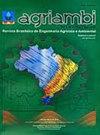垃圾填埋场渗滤液作为半干旱条件下蓖麻作物的营养来源
IF 1.4
4区 农林科学
Q3 AGRICULTURAL ENGINEERING
Revista Brasileira de Engenharia Agricola e Ambiental
Pub Date : 2018-06-01
DOI:10.1590/1807-1929/AGRIAMBI.V22N6P378-382
引用次数: 0
摘要
本文章由计算机程序翻译,如有差异,请以英文原文为准。
Percolado de aterro sanitário como fonte nutricional no cultivo da mamoneira em condições semiáridas
ABSTRACT The relevance of using technology for the rational destination of waste from a wide range of human activities is imminently paramount. In this context, between September 2014 and January 2015, in Mossoró, RN, Brazil (5º 11' 31" S; 37º 20' 40" W), the present work was conducted to evaluate strategies for the utilization of landfill leachate as source of water and nutrients in agriculture. For this, castor bean plants (Ricinus communis L.), cv. BRS Energia, cultivated in eutrophic Red Yellow Argisol, were subjected to irrigation depth application strategies, namely: initial application of leachate corresponding to 20, 40, 60 and 80% of the irrigation depth and subsequent application of the remaining water depth percentage using public-supply water, plus one control, which consisted of irrigation with public-supply water + mineral fertilization recommended for the crop. These treatments were set in randomized blocks, with four replicates, totalizing twenty experimental plots. Mineral fertilization resulted in more expressive biometric responses at the beginning of the cycle; however, at the end, treatments based on leachate led to results, including of production, compatible with the control, especially plants irrigated with the 20% irrigation depth.
求助全文
通过发布文献求助,成功后即可免费获取论文全文。
去求助
来源期刊

Revista Brasileira de Engenharia Agricola e Ambiental
Agricultural and Biological Sciences-Agronomy and Crop Science
CiteScore
2.70
自引率
16.70%
发文量
114
审稿时长
3-8 weeks
期刊介绍:
A Revista Brasileira de Engenharia Agrícola e Ambiental (Agriambi), periódico oficial da Asociación Latinoamericana y del Caribe de Ingeniería Agrícola (ALIA), é editada mensalmente, no formato eletrônico, pela Unidade Acadêmica de Engenharia Agrícola (UAEA) do Centro de Tecnologia e Recursos Naturais (CTRN) da Universidade Federal de Campina Grande (UFCG), destinando-se à divulgação de artigos científicos originais e inéditos, elaborados em Português, Inglês ou Espanhol. Com o auxílio de pareceres de Consultores, os artigos são aceitos ou não pela Equipe Editorial para publicação na Revista. A Agriambi aceita, também, a submissão de contribuições na modalidade de revisão de literatura.
 求助内容:
求助内容: 应助结果提醒方式:
应助结果提醒方式:


